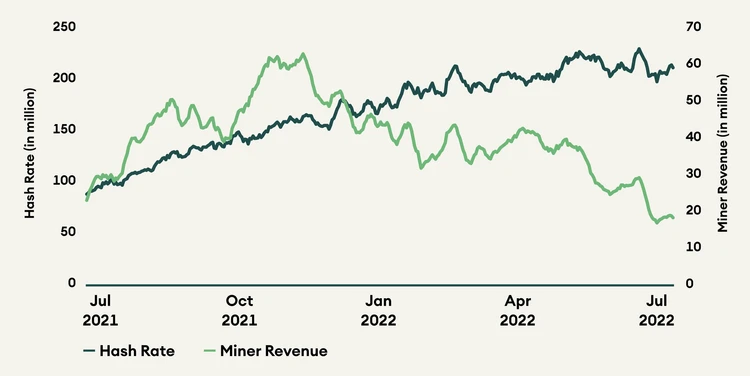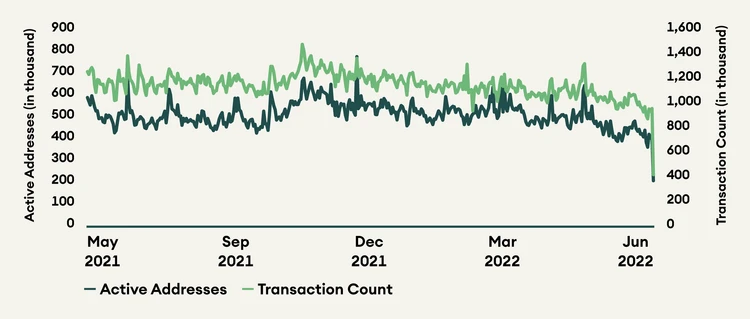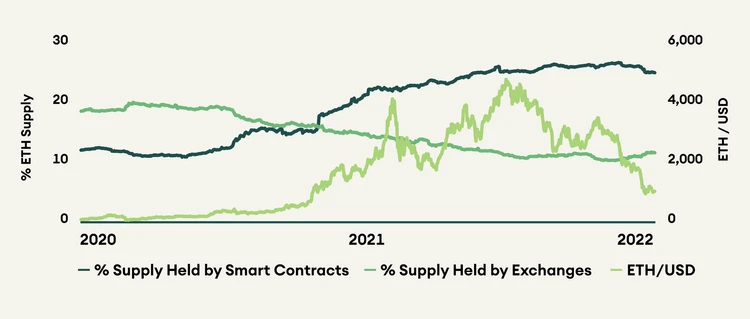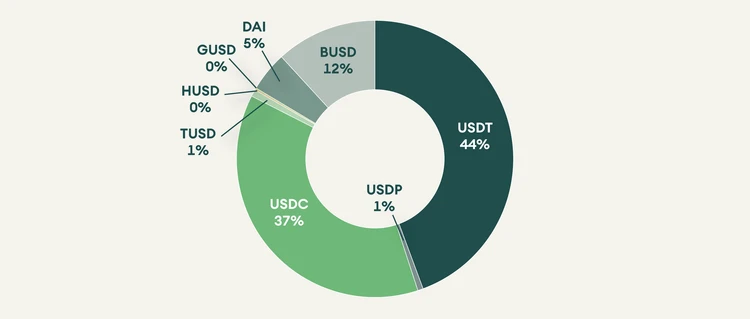Since November 2021 the crypto markets have been in a steady downtrend, closely following the footsteps of previous 4 year long bull and bear market cycles. This downward pressure has been accelerated by unfavorable macroeconomic conditions as well as the insolvency of numerous established crypto firms.
June 2022 has been one of the most devastating months in the history of crypto markets. The total market capitalisation dropped by approximately USD 500 billion after the massive fall in May, and it is now less than USD 1 trillion. The last time the crypto market capitalisation was below USD 1 trillion was in February 2021, more than 15 months ago. This correction can be attributed to several specific crypto events that we will discuss further in this article.
It is essential to note that deteriorating macroeconomic data, tighter financial conditions, and the ongoing war in Ukraine paint an unattractive investment landscape. All traditional asset classes have been affected by rising inflation, slower than expected growth numbers, and the tense geopolitical situation. Further crypto relevant events:
- Celsius stopped withdrawals of user funds and struggles with insolvency fears.
- 3AC failed to fulfill its debt obligations and announced its bankruptcy.
- Heavy losses dragging down multiple crypto firms.
Bitcoin's performance during the bear market
Bitcoin (BTC) price dropped by 35% in a single month, more than most traditional financial assets. The price-performance can be attributed to liquidations of massive collateral used by multiple CeFi entities and high selling pressure caused by reduced miner revenue.
June 2022 was the worst performance month for Bitcoin in more than a decade. The last time BTC witnessed a similar performance was in 2011. With concerns of rising inflation figures, and a potential recession in the coming months, on-chain activity for the Bitcoin network has slowed, and there is an increase in accumulation trend score, indicating that long-term holders are gradually increasing their portfolio size.

After China banned crypto mining, the Bitcoin hash rate recovered vigorously in the second half of 2021, to reach an all-time high in June 2022. The higher the hash rate, the more difficult it is to mine a block and get rewards. In other words, the cost of mining has increased while the price of bitcoin started falling in November 2021, leading to a decline in miners’ profitability. The recent fall in the hash rate indicates that the decrease in miner profitability has caused miners to disconnect some of their newly added capacity.

Further, publicly listed Bitcoin mining companies act as a proxy for investors who do not want to hold the asset directly but still want to gain exposure. Leveraging this philosophy, these mining companies started to accumulate Bitcoin that they generated through block rewards and transaction fees, increasing their reserves and hence investor confidence. They paid for mining operations through capital raised by offering equity or taking on company debt. But the recent decrease in miner revenue has caused some of these entities to sell their Bitcoin to cover costs.
Ethereum having a hard time
Ethereum (ETH) has been going through a tough time in terms of price performance, and it is down 71% this year and 40% in the last month alone. The current fiasco of CeFi lenders laying off employees and restricting access to user funds started with an Ethereum synthetic asset called Lido staked Ether (stETH).
As the Ethereum blockchain is moving to a proof-of-stake (PoS) consensus mechanism, validators required to keep the network secured must deposit 32 ETH to qualify as a validator. But these assets, once deposited, are locked in for more than a year or until after the Merge is successful. To provide liquidity for users who want to stake their ETH to secure the network but also want liquidity, Lido Finance had (LDO) the solution. In exchange for one ETH, one stETH was issued, which is a synthetic asset that accrues staking yield and can be redeemed for equivalent amount of ETH after the Merge. But as the value of one stETH started detaching from one ETH, panic was set in the market, and users rushed to swap their stETH for ETH, creating a liquidity crisis for entities with massive exposure to stETH, like Celsius.

These events reduced investor confidence in stETH and ETH for the short term, and Ethereum active addresses and transaction count kept decreasing. It touched very low levels not seen in more than a year. The uncertainty around holding ETH is also caused by the highly expected Merge of the Beacon chain, completing the transition of Ethereum, and thus ushering in a new era. However, concerns regarding efficient scaling of Ethereum are increasing as one of the critical protocols dYdX recently decided to part ways with Ethereum and chose to build its own chain in the Cosmos ecosystem.

Further, the supply of Ethereum on smart contracts has reduced as the investor confidence in the decentralised finance (DeFi) ecosystem has been shaken, given the fall of Terra Luna (LUNA) and its stablecoin (UST), reduced activity on the network, drop in Total Value Locked (TVL) and many such reasons. Subsequently, the supply of ETH on exchanges has increased, indicating sell pressure.
Alternative blockchains performing better then market leaders
All the alternative blockchain assets we cover have performed better than the leading assets, Bitcoin (BTC) and Ethereum (ETH), but recorded negative performance. The smart contract platform Avalanche (AVAX) declined by 32%, followed by a 27% correction for the interoperability ecosystem Polkadot (DOT) and 24% for Stellar (XLM).
- Litecoin (LTC) implemented one of the most anticipated upgrades to its network called MimbleWimble, a couple of months ago. It enhances the privacy of the transactions while reducing the data required to send transactions and thus enhancing the scalability of the network. But several centralised exchanges have delisted Litecoin, citing Anti-Money Laundering (AML) and Know Your Customer (KYC) laws.
- Avalanche (AVAX) launched Bitcoin bridge through their browser extension web3 wallet, called Core. It enables native Bitcoin support on the Avalanche ecosystem, allowing Bitcoin holders to directly access extensive earning and yield opportunities on DeFi applications. Important to note that this native Bitcoin support is only available through Core browser extension and is not yet supported by Metamask or any other wallet.
- Solana (SOL) blockchain continues to gain new users despite facing the massive challenge of multiple network outages in the past. Solana has the second biggest NFT ecosystem after Ethereum. Their leading NFT marketplace, Magic Eden, raised USD 130 million last month at a valuation of USD 1.6 billion, with plans to expand across multiple blockchains. Solana announced their new smartphone device and platform to bring blockchain applications natively to the device. It is expected to be available in second half of 2023.
The graphic below shows the comparison between different proof-of-stake blockchains. Solana has the highest percentage of market cap staked, followed by Cardano (ADA) and Avalanche. While Ethereum has the most significant number of validators even before it is transitioned to PoS. Polkadot offers the best yield, followed by Avalanche.

Decentralised Finance (DeFi)
Following the incident of Celsius halting all user activities, MakerDAO voted to cut off lending platform Aave’s ability to generate DAI against derivative token stETH because 50% of the DAI borrowed on Aave was by Celsius and collateralised by stETH. This indicates the risk to DeFi apps as well, created by the current insufficient risk management practices of select CeFi entities.
- Synthetix (SNX) recorded over USD 200 million in trading volumes on 20 June as its atomic swap product gained traction among traders. This was a significant increase compared to the average daily volume of USD 500k to USD 3 million. Synthetic ether (sETH) and synthetic dollar (sUSD) were the most active trading pair during this time. The token SNX was up more than 100% during the same day but has since corrected and is down 3% on a 30-day basis.
- Uniswap (UNI) is down only 4% for the month, as it overtook Ethereum in the amount of gas fees paid. Further, Uniswap acquired NFT aggregator platform Genie to integrate NFT trading along with ERC-20 trading. Uniswap will also be doing an airdrop to anyone who has used genie before 15 April 2022, and its snapshot has already been taken.
In the wake of the liquidity crisis felt by the entire crypto ecosystem over the last couple of months, it’s essential to understand the critical differences between centralised and decentralised finance platforms. The following table highlights several essential characteristics.

Since stablecoins are the backbone of the crypto economy now, the following is the market share distribution among different US dollar stablecoins operating in the market. USDC has become more popular over the last year, gaining market share from USDT.

Conclusion
The full extent of the current liquidity crisis is not entirely behind us, given that we are still witnessing multiple centralised platforms halting user withdrawals, laying off employees, and raising money for survival. Thus, it is safe to say that the negative sentiment prevails in the market, making it difficult to predict the direction in the short term. The uncertain geopolitical scenario continues to dominate the overall financial ecosystem, increasing the risk of further high inflation, slow growth, and a recession.




